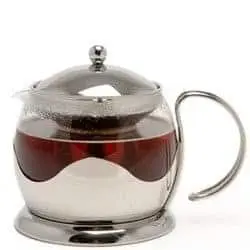Your basket is currently empty!
How to make a good cup of tea
How to make a good cup of tea: a step by step approach
By using loose leaf tea

Loose leaf tea, especially large leaf grades make the best tea, as given a little time, they enable a balanced set of flavours infuse. There are however differences in how black, green oolong or white teas should be brewed and some famous China teas and some Indian teas such as Darjeelings require some extra care to make the most of these handmade teas.
First – the water
Always use freshly run water when making tea. This is to ensure that it hasn’t picked up any flavours and to ensure that there is plenty of oxygen dissolved in the water. Never use hot water that has been heated over a long period such as in a coffee making still. It may not have boiled and may be the wrong temperature for the tea you are making.
Secondly – the tea
Use tea that has been stored correctly in an air-tight container, away from heat, dampness and sunlight. Black tea has a long shelf-life but green tea should be used within six months and flavoured teas can loose their fragrance within a few months.
Thirdly – the teapot
Use a teapot with a removable infuser. These allow the leaf to be removed when the desired strength has been achieved. Glass teapots are particularly good for this. If you choose to use a more traditional teapot ensure that it has a ‘cage’ at the base of the spout. This is a series of holes to catch the leaf so that it does not pass into your cup, or worse, block the spout. A few leaves in your cup don’t matter as they tend to sink but too many is unpleasant and of course will continue to infuse once poured.
Yixing teapots
There are traditional China Yixing teapots which became popular from the beginning of the Ming dynasty in 1368. These small red clay teapots from Jiangshu province are best for oolong and black teas. They are beautifully made, unglazed and have tight fitting lids. The capacity is typically only 200 cl. Using the Gongfu method used in the Chinese tea ceremony they are completely filled with leaf, the leaf is washed in hot water, poured away and then infused for a short time, as little as thirty seconds. Successive infusions of progressively longer duration are then possible.
Do not use the same teapot for black teas and green teas. The tannins deposited inside the teapot from the former will spoil green tea. The build-up of these tannins for black teas is favourable as it improves the flavour. Only rinse a teapot after use. Do not use detergents.
Metal teapots are not recommended as they can taint the tea. Good quality stainless steel is least likely to do this. Enameled, cast iron teapots look great but they take a lot of heat from the tea.
How much tea?
For black teas use one teaspoon (around 3 grams tea per person) and one for the pot. For large teapots do not add this extra spoon. Too often teas are made to weak and it is important to appreciate the distinctive characteristics of the tea.
Temperature of the water
Black teas need boiling water. For oolong and green teas allow the boiled water to cool a couple of minutes so that its temperature has fallen to 75-80 degrees Celsius. Using water that is too hot with green teas can make them bitter.
How long to brew?
Black teas need around three to five minutes. Green teas need three to four minutes and can be infused repeatedly for shorter periods using the Gongfu method described above. White teas can be infused around five minutes or using repeated short infusions. Larger leaved teas require longer to infuse as their surface area relative to their volume is smaller. Small leaf black teas should not be infused longer than three minutes to ensure that the tannins do not become too prominent.
Milk?
Milk can be taken with full-bodied black teas such as Assams, Kenyan teas, Ceylon Dimbulas and even some China Keemuns such as Mao Feng. Generally however many black teas are better without, especially Darjeelings and lighter bodied blends such as Earl Grey based upon China and Darjeeling teas.
Should milk be added to the cup before or after tea?
I suggest before. This is so that you can judge better how much milk is used. It is all too easy to add too much. Adding it first avoids the need to stir your tea and it helps avoid staining fine porcelain. If you are really unsure how much milk to used, add it afterwards but you cannot pour it back if you have used too much!
Sugar?
Avoid. It should be unnecessary.
Making a good cup of tea should be a simple process but as the Chinese and Japanese tea cultures acknowledge, simplicity requires care, especially if you are to make the most of your carefully chosen teas!
Visit our Tea Store.
